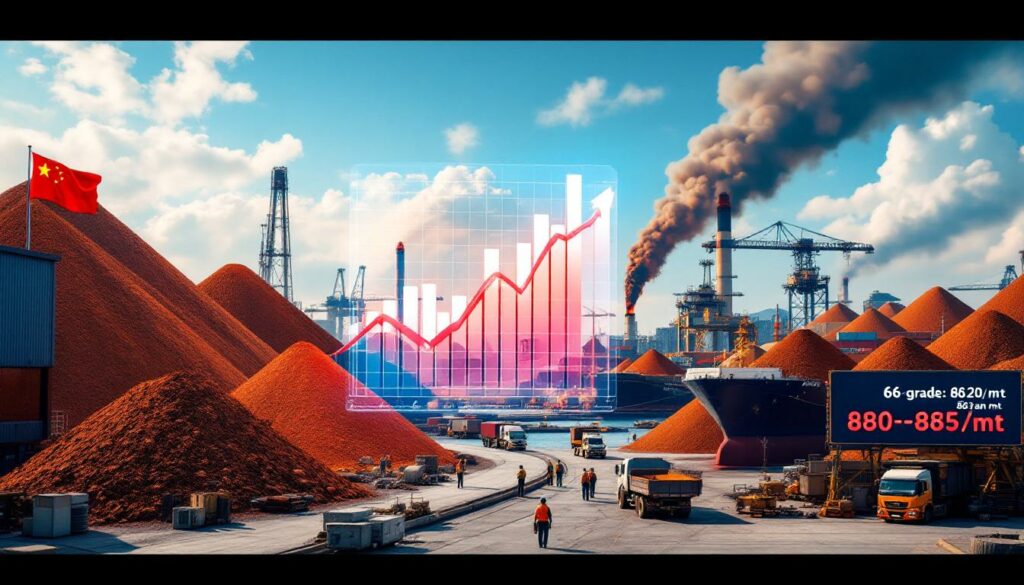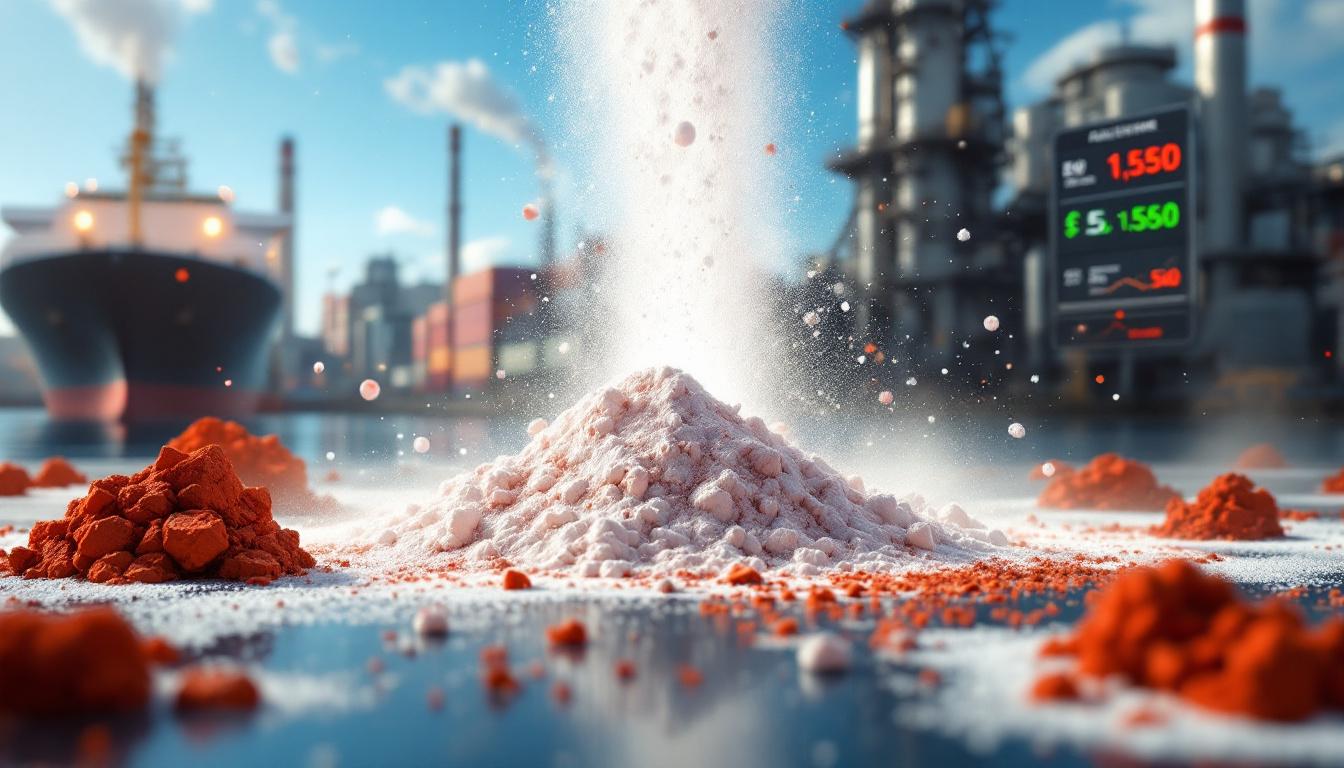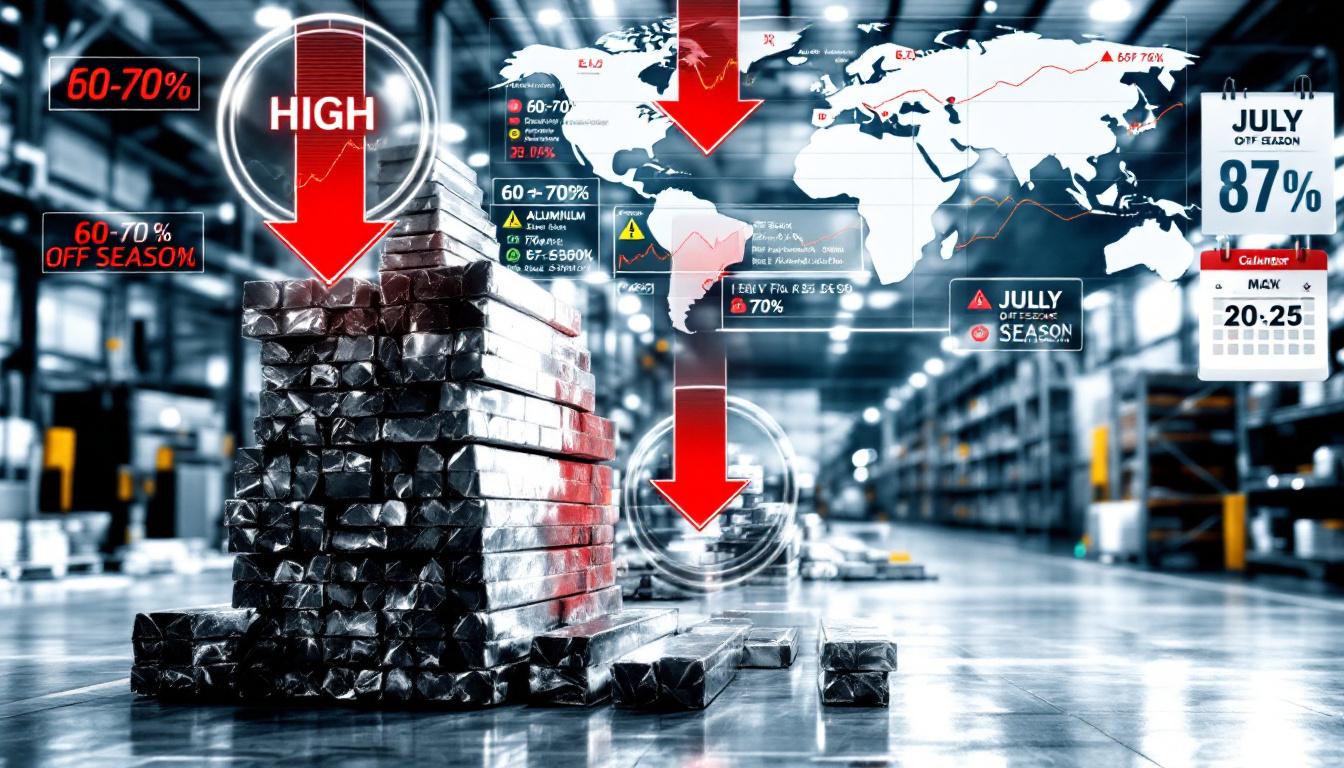Current Iron Ore Price Trends in Tangshan: Market Analysis
The iron ore market in Tangshan is experiencing significant price movement amid complex supply-demand dynamics. Recent data shows notable price increases for high-grade concentrates, while market participants navigate constraints in domestic production and shifting cost dynamics between domestic and imported materials. The current iron ore trends indicate a market responding to multiple pressures simultaneously.
Price Movements and Key Market Metrics
In the latest trading sessions, Tangshan's premium 66-grade iron ore concentrates have increased by 20 yuan to reach 880-885 yuan/mt (dry-basis, tax-included, delivery-to-factory). This upward movement highlights the strength in higher-grade materials despite mixed market sentiment.
PB fines in Tangshan are maintaining stability, trading in the 735-740 yuan/mt range. This represents a noteworthy regional premium compared to Shandong's PB fines, which are trading at 720-725 yuan/mt. The price differential reflects Tangshan's strategic importance as a steel production hub and the associated logistics advantages.
On the futures market, the DCE iron ore contract I2509 recently settled at 732.5, reflecting a 0.62% daily increase. This modest gain suggests cautious optimism among futures traders despite mixed fundamental indicators.
Cost-effectiveness shifts: Domestic iron ore concentrates have improved their competitive positioning against imported alternatives. This change in the comparative economics between domestic and imported materials is influencing purchasing decisions at steel mills, with many showing increased interest in domestic supply when available.
Supply Constraints Supporting Prices
The current price resilience can be attributed to several supply-side constraints affecting Tangshan's iron ore market:
- Limited mine output: Mines and beneficiation plants continue to face tight overall supply conditions for iron ore concentrates
- Safety inspection pressures: Ongoing safety protocols are restricting production at various mining operations
- Moderate sales willingness: Despite improved market positioning, producers are showing restrained enthusiasm to sell, maintaining price discipline
- Environmental protection measures: Regulatory oversight continues to impact production capabilities across the supply chain
An industry analyst from Shanghai Metal Market notes: "The supply constraints at domestic mines remain a significant factor supporting prices, though producers maintain a cautious approach to increasing output despite favorable market conditions."
Regional Market Comparisons and Price Premiums
Tangshan's iron ore market commands notable premiums compared to other regional hubs, reflecting its strategic importance in China's steel industry ecosystem.
| Region | Product | Price Range (yuan/mt) |
|---|---|---|
| Tangshan | PB Fines | 735-740 |
| Shandong | PB Fines | 720-725 |
| Tangshan | Low-sulfur coking coal | 1,200 |
| Linfen | Low-sulfur coking coal | 1,180 |
The price differentials between regions reflect:
- Transportation cost variations
- Regional supply-demand balances
- Quality differences in locally available materials
- Proximity to major steel production centers
Tangshan's position as a key steel production hub creates natural demand pressure that supports its price premium. The 15-20 yuan premium for PB fines compared to Shandong represents approximately a 2-2.5% price differential, which aligns with typical logistics cost structures between the regions.
Supply Chain Interconnections
The iron ore market in Tangshan operates within a complex network of interconnected raw material markets that collectively influence steel production economics.
In the coking coal segment, transaction activity has shown improvement with more active online bidding processes. Mine inventory levels have declined slightly, reducing pressure on sellers to offload material and providing support for price stability. Meanwhile, coke producers face output limitations due to environmental inspections, creating potential constraints in the metallurgical coal supply chain.
Steel mills are maintaining blast furnace operations at relatively high utilization rates despite various market pressures, sustaining demand for iron ore and other steelmaking raw materials. Furthermore, understanding the various market types and deposits is crucial for grasping the full picture of Tangshan's iron ore dynamics.
Market Sentiment and Trading Behavior
Current market sentiment in Tangshan's iron ore trade reflects a cautious balance between moderate optimism and practical constraints.
Fundamental Market Indicators
Several key fundamentals are supporting the current market structure:
- Moderate steel mill profitability: Despite various cost pressures, steel producers continue to maintain workable profit margins
- Sustained pig iron production: High blast furnace utilization rates are maintaining consistent demand for iron ore
- Limited fundamental contradictions: The market lacks severe imbalances that would trigger sharp price movements
- Resilient demand patterns: Despite seasonal fluctuations, underlying demand remains sufficiently robust to prevent significant price deterioration
The combination of these factors creates a relatively stable foundation for iron ore prices, though short-term fluctuations remain likely based on trading patterns and incremental news developments. The latest price forecast analysis suggests this stability might continue through the near term.
Trader and Mill Behavior Patterns
The interaction between traders and steel mills reveals interesting market psychology currently at work in Tangshan:
"The market trading atmosphere was moderate in the week. Steel mills purchased as needed, with inquiries tapering off approaching the weekend."
– Shanghai Metal Market Morning Meeting Summary, July 7, 2025
Steel mills are employing strategic purchasing behaviors, including:
- Primarily buying on an as-needed basis rather than building significant inventories
- Exerting strong bargaining pressure despite stable prices
- Demonstrating selective purchasing patterns based on price and quality considerations
- Maintaining a competitive mindset in negotiations with suppliers
Traders, meanwhile, are actively offering cargoes while navigating the selective purchasing patterns of mills. This dynamic creates a balanced negotiation environment where neither side holds overwhelming leverage.
Short-Term Price Outlook for Tangshan Iron Ore
The outlook for Tangshan's iron ore market in the coming weeks reflects a complex interplay of supportive fundamentals and potential headwinds.
Supporting Factors for Price Stability
Several elements continue to provide support for iron ore prices in the Tangshan market:
- Sustainable steel mill economics: Decent profitability levels at steel producers maintain production incentives and raw material demand
- Resilient underlying demand: Despite seasonal patterns, fundamental demand provides support at lower price levels
- Positive market sentiment: Recent supportive macroeconomic news has bolstered overall market confidence
- Limited industrial contradictions: The absence of severe market imbalances reduces the likelihood of sharp corrections
An experienced iron ore trader commented that "the current balance between supply constraints and moderate demand creates a foundation for price stability, though upside potential may be limited by increasing arrivals at ports."
Potential Price Pressures
Despite supportive factors, several elements could introduce downward pressure on iron ore prices:
- Increasing overseas shipments: Expected to boost port arrivals in the coming weeks
- Quarter-end production targets: Growing supply-side pressure as mines pursue production goals
- Seasonal demand weakness: Typical summer slowdown affecting downstream consumption patterns
- Policy uncertainties: Potential disruptions from ongoing tariff negotiations with an August 1 implementation date
- Politburo meeting expectations: Market sensitivity to policy signals from the upcoming July Politburo meeting
"Ore prices may extend their strength, but close attention should be paid to potential short-term disruptions from policy news like tariff negotiations."
– Shanghai Metal Market Morning Meeting Summary, July 7, 2025
The balance between these supporting and pressuring factors suggests Tangshan iron ore prices may fluctuate within a relatively narrow range in the short term, with traders carefully monitoring policy developments and inventory trends for directional cues. Recent declining supply impact has been a significant factor in current price structures.
Related Markets Performance and Impact on Iron Ore
The performance of adjacent markets provides important context for understanding Tangshan's iron ore price dynamics, as these interconnected raw materials collectively determine steel production economics.
Coking Coal Market Conditions
The coking coal market is showing signs of stabilization with potential for modest upward movement:
- Safety inspection impact: Partial mine suspensions in certain regions are constraining supply
- Inventory dynamics: Reduced coal inventory at mines is strengthening price resilience
- Transaction activity: Improved trading volumes with more active online bidding
- Regional pricing: Low-sulfur coking coal in Tangshan offered at 1,200 yuan/mt versus Linfen's 1,180 yuan/mt
The constrained coking coal supply environment provides indirect support for iron ore prices by maintaining overall steelmaking cost structures and preventing significant production cost reductions that might pressure iron ore negotiations.
Coke Market Analysis
The metallurgical coke market shows a structured price hierarchy based on grade and processing technology:
| Grade/Type | National Average Price (yuan/mt) |
|---|---|
| First-grade (dry quenching) | 1,440 |
| Quasi-first-grade (dry quenching) | 1,300 |
| First-grade (wet quenching) | 1,120 |
| Quasi-first-grade (wet quenching) | 1,030 |
Production limitations stemming from environmental inspections and profitability concerns are influencing coke availability. Industry analysts note that "coke fundamentals have gradually improved, with stable cost support. Short-term coke prices may stabilize, with some upward potential."
This stability in the coke market contributes to the overall raw material cost structure for steel mills, indirectly influencing iron ore pricing power and negotiation dynamics in Tangshan. According to Trading Economics data, these interconnected markets have significant implications for overall iron ore price formation.
Downstream Steel Market Developments
The performance of finished steel markets provides crucial context for understanding iron ore demand patterns and pricing power in Tangshan.
Rebar Market Trends
The construction steel sector shows signs of modest improvement:
- Price movements: Nationwide average rebar price reached 3,118.6 yuan/mt, up 57.4 yuan week-over-week
- Production adjustments: Mills in Yunnan and Guizhou have announced production cut plans, though implementation remains uncertain
- Mill operations: Electric arc furnace (EAF) operations show slight increases in operating rates despite ongoing profitability challenges
- Inventory patterns: Market activity improving with rising prices, though seasonal pressures remain
The modest price improvement in rebar markets provides some support for steelmaking raw materials, including iron ore, by improving overall mill economics and sustaining production incentives.
Hot Rolled Coil (HRC) Developments
The flat steel segment presents a more complex picture:
- Futures performance: HRC futures recently settled at 3,201, representing a 0.25% daily increase
- Production trends: Weekly production increased by 2,900 mt to reach 3.3685 million mt
- Demand softness: Weakening orders from home appliance and automotive sectors
- Processing segment: Cold-rolled orders slowing alongside structural steel demand
- Inventory dynamics: HRC inventory accumulating with expanding increments, indicating supply-demand imbalance
"HRC inventory kept accumulating with expanding increments, as supply-demand imbalance persisted… Actual demand improved marginally."
– Shanghai Metal Market Morning Meeting Summary, July 7, 2025
The mixed performance in downstream steel markets creates a nuanced demand environment for iron ore. While construction steel shows modest strength, the manufacturing-oriented flat steel segment faces greater challenges, potentially limiting overall iron ore demand growth.
Key Market Indicators to Monitor
For market participants tracking Tangshan's iron ore market, several critical indicators merit close attention to anticipate price movements and market shifts.
Critical Supply Metrics
Supply-side indicators provide essential visibility into potential price pressures or support:
- Port inventory levels: Current stocks and arrival rates of imported ore
- Mine production rates: Output trends at domestic mines and beneficiation plants
- Coking coal availability: Supply constraints amid ongoing safety inspections
- Blast furnace operations: Utilization rates at steel mills indicating production intensity
Industry analysts recommend tracking the relationship between port arrivals and mill consumption rates as a key leading indicator of potential price movements. When arrivals consistently exceed consumption, inventory accumulation typically precedes price pressure.
Demand Signals to Monitor
Demand-side indicators offer insights into the sustainability of current price levels:
- Steel mill profitability: Margins and production decisions
- Downstream purchasing patterns: Order books and consumption rates
- Inventory accumulation: Stock levels across the supply chain
- Seasonal demand fluctuations: Construction and manufacturing activity cycles
The balance between steel production economics and end-user demand remains critical for sustained iron ore pricing power. When mill margins compress, purchasing behavior typically becomes more selective and price-sensitive. Understanding miners demand insights provides additional context for these market dynamics.
Policy and External Factors
Regulatory and macroeconomic factors can introduce significant market disruptions:
- Environmental protection measures: Implementation intensity and geographic scope
- Safety inspection regimes: Impact on production capabilities across the supply chain
- Tariff negotiations: Potential changes affecting international trade economics
- July Politburo meeting: Expectations for policy signals affecting industrial activity
"Close attention should be paid to potential short-term disruptions from policy news like tariff negotiations."
– Shanghai Metal Market Morning Meeting Summary, July 7, 2025
Market participants should maintain awareness of policy calendar events and regulatory announcements that could trigger rapid sentiment shifts even when fundamental conditions appear stable.
Understanding Tangshan Iron Ore Market Dynamics: Frequently Asked Questions
What factors are currently supporting iron ore prices in Tangshan?
Several key elements are providing price support in the current market:
- Moderate steel mill profitability maintaining production incentives
- Sustained high pig iron production rates driving consistent demand
- Tight domestic ore supply due to ongoing safety and environmental constraints
- Positive market sentiment influenced by supportive macroeconomic signals
These factors collectively create a foundation for price stability, though the market remains vulnerable to shifts in any of these supporting elements.
How are steel mills responding to current iron ore price levels?
Steel producers in the Tangshan region are demonstrating strategic purchasing behavior:
- Maintaining a cautious approach with primarily as-needed purchasing
- Exerting strong bargaining pressure despite their moderate profitability
- Selectively evaluating domestic versus imported options based on comparative economics
- Balancing inventory management against price risk considerations
This disciplined approach reflects mills' experience navigating market cycles and their efforts to optimize raw material costs amid fluctuating steel prices.
What is the relationship between domestic and imported iron ore prices?
The economic relationship between domestic and imported iron ore has shifted recently:
- Domestic iron ore concentrates have improved their cost-effectiveness relative to imported alternatives
- This shift reflects both domestic supply constraints and changes in international pricing
- Quality differentials remain significant, with higher-grade imported ores commanding appropriate premiums
- Logistical considerations, including port congestion and inland transportation costs, influence the comparative economics
Steel mills continuously evaluate this relationship when making purchasing decisions, often blending materials to optimize cost and quality requirements.
How might upcoming policy decisions affect the Tangshan iron ore market?
Market participants should monitor several potential policy impacts:
- Tariff negotiations: Changes could alter import economics and domestic/import price relationships
- July Politburo meeting: Policy signals might influence industrial activity expectations
- Environmental enforcement: Intensity variations could affect both mining and steel production
- Safety inspection regimes: Implementation patterns impact domestic ore availability
Despite current fundamental stability, policy developments retain significant potential to introduce short-term market disruptions that could influence pricing trends.
Disclaimer: This analysis contains forward-looking statements about iron ore market conditions. Future events may differ materially from current expectations. Readers should conduct their own research and analysis before making investment or business decisions.
What geological factors influence Tangshan's iron ore quality and pricing?
The geological characteristics of Tangshan's iron ore deposits significantly impact market dynamics:
- Iron content variation: Domestic ores typically feature lower iron content (30-40%) compared to premium Australian and Brazilian imports (60-65%)
- Impurity profiles: Higher silica and alumina levels in some domestic deposits necessitate additional processing
- Deposit accessibility: Varying overburden ratios and extraction challenges affect production economics
- Beneficiation requirements: Additional processing needed to achieve commercially viable concentrate grades
These geological realities create natural cost differentials between domestic and imported materials that influence price relationships and mill purchasing decisions.
How do seasonal factors impact iron ore demand in Tangshan?
Seasonal patterns create predictable fluctuations in the iron ore market:
- Summer construction slowdown: Reduced activity during hot weather and rainy periods
- Winter heating season: Production restrictions during high pollution periods
- Spring construction peak: Accelerated activity following Lunar New Year
- Year-end inventory management: Destocking ahead of financial reporting periods
Understanding these seasonal rhythms helps market participants anticipate demand shifts and potential price movements throughout the annual cycle. According to the latest mining.com report, these seasonal patterns continue to play a significant role in market behavior.
Looking to Track the Next Major Mineral Discovery?
Discovery Alert's proprietary Discovery IQ model provides real-time notifications on significant ASX mineral discoveries, delivering actionable insights for both short-term traders and long-term investors. Explore how historic discoveries have generated exceptional returns by visiting our dedicated discoveries page and begin your 30-day free trial today to gain a market-leading advantage.




